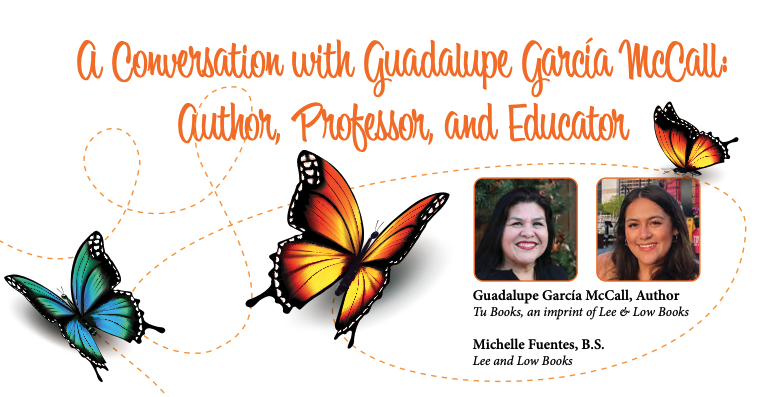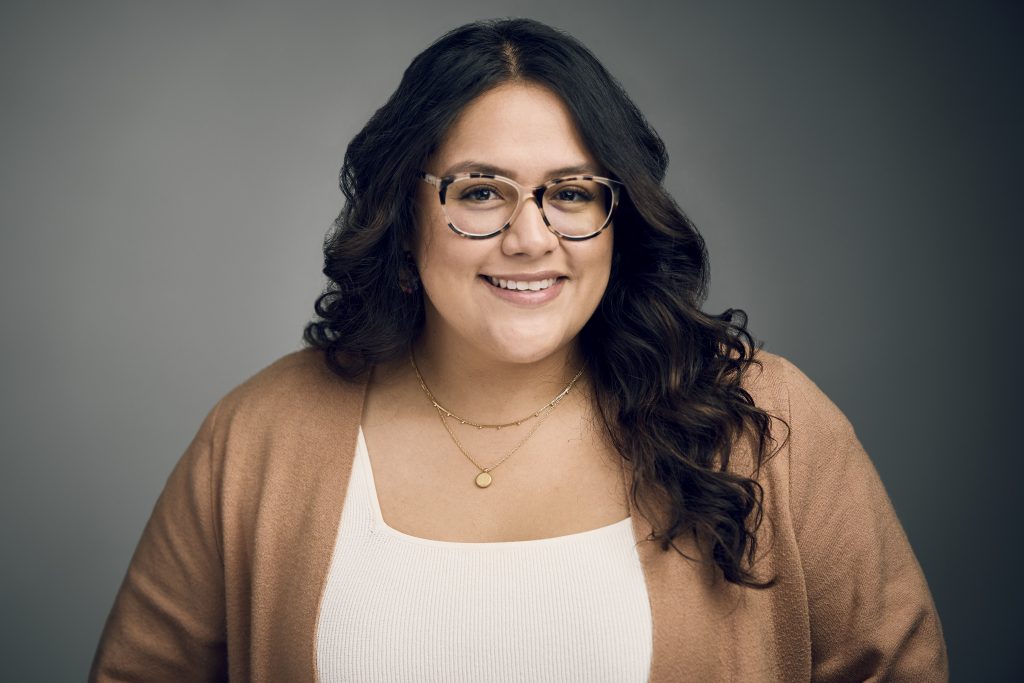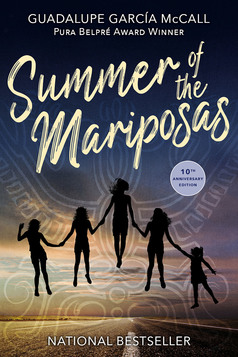
This Q&A with author and former teacher Guadalupe García McCall and Lee & Low Literacy Specialist Michelle Fuentes originally appeared in the CABE 2023 Edition of Multilingual Educator. Guadalupe’s latest novel, Echoes of Grace, is available wherever books are sold!

Guadalupe García McCall is the award-winning author of Summer of the Mariposas (El verano de las mariposas) and won the Pura Belpré Award for her first novel, Under the Mesquite. She was born in Piedras Negras, Coahuila, México, and moved to Eagle Pass, Texas as a young girl, keeping close ties with family on both sides of the border. She taught secondary students from grades six through ten for twenty-four years in San Antonio, Texas. She recently retired as an assistant professor at George Fox University in Oregon. She is a full-time author and abuelita. Find her online at ggmccall.com.

In this conversation with Michelle Fuentes, former English to Speakers of Other Languages (ESOL) middle school educator and current Literacy Specialist at Lee & Low Books, Guadalupe shares her experiences and strategies working with students to support their bilingualism, biculturalism, and biliteracy. This interview has been edited for length and clarity.
What strategies work well with students to support bilingualism, biculturalism, and biliteracy?
Michelle Fuentes: As a Spanish and ESOL teacher, I learned many strategies to help students acquire language. I consistently used real-life examples to help students connect with the content, which helped increase student engagement and understanding. As an ESOL educator, it is also important to break down barriers that English Language Learner (ELL) students may feel when learning English. You must reinforce and educate students that their native language is a tool that has put them ahead of others because they already know another language. It is a lot of work changing some students’ mindsets about their limited English proficiency. I did a lot of work with my students to teach them that their language is an asset and to use it. I taught students how to use cognates in their learning, as well as how to convey language through body movements and cues.
Guadalupe García McCall: Well, I did not teach in a bilingual classroom. My middle and high school students had a bilingual teacher and classroom available to them. However, even though I was not teaching in a bilingual or dual language classroom, I am bilingual. I always knew the majority of my students were bilingual, so I always expected this to be a part of my classroom.
Often, my students were behind, and I would have to teach the grade-level standards and expectations for student writing from the ground up. We would start with the basics, such as the components of an essay. That was the hardest part—to get them to that grade level competency so they could express themselves and not be limited.
Regarding strategies, I would use a lot of visuals, from graphic organizers to anchor charts; even in high school, I found these useful. If I were teaching, say, metaphor, I would use picture books that can break down complex issues and concepts in concise ways. I would have anchor charts posted around the room year-round for students to access, to remind them of what they had learned and how far we had come together. I used lots of acronyms as well. For example: What do you need to be a good writer? A PEN: Answer the question, Prove it, Explain your proof, and bring New insight. Also, in many songs and audio recordings, we’d compare songs and ask ourselves, “What are they saying, thinking, feeling, believing?” I’d use physical response for characterization, setting, or literary devices. I noticed they would physically do these with me, even in 10th grade, which was so much fun.
Michelle: I also used a lot of scaffolding strategies in my teaching. I always reminded my students that they can rely on their native language, “You are ahead of the game. You know another language that others do not. Use your language as an asset.” You can teach them the use of cognates, “You know 95% of the words you hear. Use that to your advantage, and eventually, you will learn the 5% you don’t know.” Don’t let them spiral downwards into the thought that they don’t know the English language. They can associate their knowledge of known words and work with the context you are speaking about or teaching.
What strategies, as an educator, have you used while working in environments non-supportive of bilingualism?
Guadalupe: Fortunately, I haven’t worked in that environment. I did work in an area with many marginalized families. Our students were facing a lot of financial hardships. I related to these students. The people in the community where I taught were in the kind of circumstances I had experienced myself. As a young child, we were middle class, but that changed fast. We became very poor after my mother passed away. All our money and savings went to trying to save her from cancer. So, I know what it is like not to have money to go on a field trip or even not to have $5 for pizza on the field trip. But, I also know what it feels like to be in 4th grade when the teacher asks what the word “aggregate” means and to know it means to add to your basket. I knew this because I was the kid that was going to the market and cooking with my mom, and we would “aggregar” an ingredient when we made dinner. In class that day, when the teacher asked what the word aggregate meant, everyone else was stuck on the word, but it felt simple to me. “See?” my teacher would say to us. “You are ahead of the game.” And it’s true. Spanish is a superpower.
Michelle: I have been lucky to work in environments where the administration was supportive of bilingualism. However, there have been instances when I worked in an environment where the administration wasn’t as well informed about the best practices to help support our bilingual students and families. My role as an educator was to advocate for what we should do instead. Also, by using visuals and graphic organizers in class, you can break down concepts that might otherwise be difficult for students. These visual supports demonstrate to students how simple and powerful it can be for students still acquiring English.
What strategies do you as an educator use to build trust with parents and caregivers, especially those who do not speak English?
Guadalupe: I saw that parents think the school and classroom space doesn’t belong to them. Parents feel anxious and think they are lacking something, such as being unable to speak English. It was my job and my colleagues’ job to convey to the parents, “You are not lacking. You are adding to our classroom.” It is critical to have a welcoming attitude with parents, even in the secondary grades. Chicanos—we are always building community. So, I would advise teachers to do the work: Make the phone calls to invite parents in and update them on what is going on this time of year in school. My colleagues and I knew the answer to the question: How do you get the parents in? We feed them! This is important because I would make you food if you were in my house. What is food, if not love? I would always ask the principal, “What are we going to feed our parents?” Like in The Odyssey, there is this Law of Hospitality that’s come down from the ancients— feed the stranger. But we must remember that parents are not strangers. We have to welcome parents into our hearts. We want to emphasize: We want you here, and we need you here because these are your children, and we want to build this community with you. Because, as an educator, I want them to see the face to whom they entrust their child.
Michelle: If the parents or caregivers don’t trust you, the students don’t trust you. You see that play out in the classroom. As you said, food is a conversation starter. Make those phone calls home. Teaching in the Southeast, it was rare to have a Latina who spoke Spanish in the classroom. The relief I would hear in my students’ families’ voices was beautiful and sad. I would ask myself, “Why did it take so long for parents to feel included?” A parent would say how much of a relief it was, “We have been wanting this for such a long time. We are so glad to have you.” Parents really want to be involved. They feel intimidated by the classroom and school. As educators, we must remind parents that they are an asset to the success of their students in the classroom. It’s critical for teachers to make an authentic connection with parents during the first few weeks of school so that parents know to whom they are entrusting their child. Additionally, we as educators need to shift mindsets for parents that their engagement and participation are just as important as their child’s. Caregivers ARE a key component to the success and development of their students, both in and outside the classroom.
How do you show up as your authentic self in the classroom and in text? How do you encourage your students to do the same?
Guadalupe: I learned early on that I can’t be anyone but myself. I’ll tell you a story. I was in second grade, and my mom thought I would magically come home and know English by then, but it hadn’t happened yet. Every day I felt pressured when she asked, “What did you learn today?” Finally, I got so tired of “What did you learn?” that I started to mumble things she couldn’t decipher. So she started to quiz me and asked, “What is the word for our casa?” And instead of saying, “I don’t know,” I made up a word. And she caught me. She knew it was home or house because she asked someone in the neighborhood. She went to the school the next day and told the teacher I was not learning English and she was concerned. The teacher said, “Guadalupe is great; she’s a very engaged student.” To prove it, I read all these sight words in front of her. My mom was very excited and said, “We will go to Mexico to tell my abuelita.” So that weekend, we went to Las Cien Casas, and I saw people going to my abuelita’s house. And when I went inside, I saw all these folding chairs facing me. Mom stood in front of them and said: “Speak the English.” My little brain was vibrating, and I kept thinking, “What’s the English? I can’t lie.” So, I only spoke what I knew. “Run, Jane, run; Go, spot, go!” I exclaimed. I recited all the Dick and Jane books, and they loved it. Looking back at that moment, I learned to be myself. If I am just myself, people will accept me. It is important to teach children, “You are always learning new things.” It’s important to know our story and how far we’ve come. I always tell young people, “If I can do this, I can’t wait to see what you are going to do when you grow up!” It is empowering for students to see themselves in us, to see us as human beings who have overcome obstacles and are now standing in front of them as examples of what can be accomplished in this world.
Michelle: It is important to show up with who you are and admit we are human. If we make a mistake, we own the mistake at that moment. There is power in that. In this age of social media, there is pressure to be perfect all the time. It is powerful for teachers not to be afraid to be human. Own the fact that you are who you are and that, at the end of the day, you are also human. It is powerful for students to see that their teachers are also human in both beautiful and not-so-beautiful ways. There are lessons that students can take from that because they can see how we show up in the classroom. I make it a point to own up to my mistakes when I make them in class, I address that I made a mistake because then students can see how I come back from making that mistake and how I learn from it. What advice do you give educators to see their role in book selection as an asset and not something to be feared? How can educators still bring cultural responsiveness to their teaching and/or to book selection day-to-day, even if they have a required curriculum?
Guadalupe: We need to remind ourselves and tell our administrators that we are not supplanting, not replacing, not substituting the curriculum. We are, in fact, enriching the curriculum. When I wrote Summer of the Mariposas, I didn’t want people to stop reading The Odyssey—completely the opposite. After, or perhaps as, they read Summer of the Mariposas, I want students to read The Odyssey. I want to invite young people to find the commonalities, to make connections from so long ago and across cultures and times to our world as it stands today. It’s important for students to see a different culture, its values, what the people nurtured in their community, and how we are still doing that. How can we expand on that understanding if we don’t read other voices? Educators must remember we are enriching the curriculum to teach the big ideas, make connections, and add perspectives.
Michelle: It is important for teachers to be able to express the different voices that books bring into the classroom. There are lessons, themes, and ideas that students and teachers alike can learn from because they are exposed to different viewpoints.
Why do you think infusing your culture into your writing is important?
Guadalupe: We want to be seen as a community. I want the world to see that, at our core, we are all alike. We are all these beautiful, divine creatures trying to find our place in the universe. Students need to see themselves in literature. This is one of the reasons Summer of the Mariposas has done so well. It has so much of who we are as Hispanics. Mexican American students recognize themselves. Summer of the Mariposas makes Hispanic students experts in the curriculum when they see themselves in the pages of this book. “I know that; let me tell you about that,” they say, and that’s beautiful. That’s a blessing.
Michelle: I’ve seen that power it holds as a Mexican-American and Latina. I, too, connected with your book, Summer of the Mariposas. When a student is disengaged, you see the light in their eyes when you mention something relevant to them. They immediately fix their posture, and you see how jittery they are in their wanting to participate. I remember a time I made a reference to La Llorona in class. I asked, “Anyone heard about it?” Students were super eager to share with students. Students want to be experts and teach others about their culture.
What advice do you have for young people who want to pursue writing?
Guadalupe: Writing is a beautiful endeavor because it is connected to the heart. You will work hard when you’re trying to write. Do it anyway. Use the best muscle (after your brain) that you have been given—your heart. You will give so much to the world with your words.
Strategies for supporting English learners and bilingual learners:
- Total body response
- Graphic organizers
- Anchor charts and acronyms
- Picture books
- Songs and audio
- Encouraging the use of students’ native languages to solve in English










